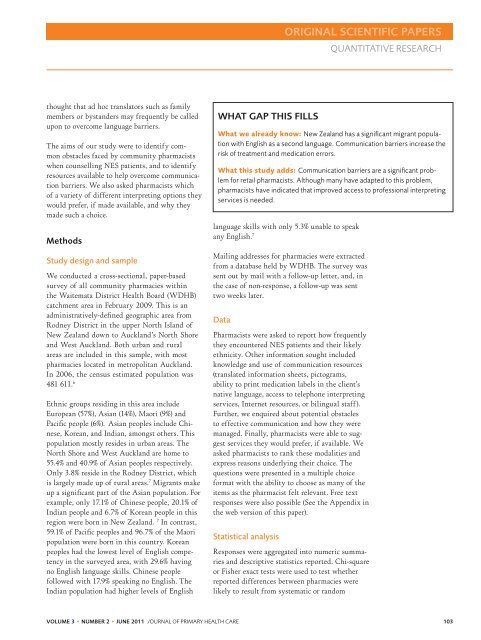single PDF of the entire issue - The Royal New Zealand College of ...
single PDF of the entire issue - The Royal New Zealand College of ...
single PDF of the entire issue - The Royal New Zealand College of ...
You also want an ePaper? Increase the reach of your titles
YUMPU automatically turns print PDFs into web optimized ePapers that Google loves.
ORIGINAL SCIENTIFIC PAPERS<br />
quantitative research<br />
thought that ad hoc translators such as family<br />
members or bystanders may frequently be called<br />
upon to overcome language barriers.<br />
<strong>The</strong> aims <strong>of</strong> our study were to identify common<br />
obstacles faced by community pharmacists<br />
when counselling NES patients, and to identify<br />
resources available to help overcome communication<br />
barriers. We also asked pharmacists which<br />
<strong>of</strong> a variety <strong>of</strong> different interpreting options <strong>the</strong>y<br />
would prefer, if made available, and why <strong>the</strong>y<br />
made such a choice.<br />
Methods<br />
Study design and sample<br />
We conducted a cross-sectional, paper-based<br />
survey <strong>of</strong> all community pharmacies within<br />
<strong>the</strong> Waitemata District Health Board (WDHB)<br />
catchment area in February 2009. This is an<br />
administratively-defined geographic area from<br />
Rodney District in <strong>the</strong> upper North Island <strong>of</strong><br />
<strong>New</strong> <strong>Zealand</strong> down to Auckland’s North Shore<br />
and West Auckland. Both urban and rural<br />
areas are included in this sample, with most<br />
pharmacies located in metropolitan Auckland.<br />
In 2006, <strong>the</strong> census estimated population was<br />
481 611. 6<br />
Ethnic groups residing in this area include<br />
European (57%), Asian (14%), Maori (9%) and<br />
Pacific people (6%). Asian peoples include Chinese,<br />
Korean, and Indian, amongst o<strong>the</strong>rs. This<br />
population mostly resides in urban areas. <strong>The</strong><br />
North Shore and West Auckland are home to<br />
55.4% and 40.9% <strong>of</strong> Asian peoples respectively.<br />
Only 3.8% reside in <strong>the</strong> Rodney District, which<br />
is largely made up <strong>of</strong> rural areas. 7 Migrants make<br />
up a significant part <strong>of</strong> <strong>the</strong> Asian population. For<br />
example, only 17.1% <strong>of</strong> Chinese people, 20.1% <strong>of</strong><br />
Indian people and 6.7% <strong>of</strong> Korean people in this<br />
region were born in <strong>New</strong> <strong>Zealand</strong>. 7 In contrast,<br />
59.1% <strong>of</strong> Pacific peoples and 96.7% <strong>of</strong> <strong>the</strong> Maori<br />
population were born in this country. Korean<br />
peoples had <strong>the</strong> lowest level <strong>of</strong> English competency<br />
in <strong>the</strong> surveyed area, with 29.6% having<br />
no English language skills. Chinese people<br />
followed with 17.9% speaking no English. <strong>The</strong><br />
Indian population had higher levels <strong>of</strong> English<br />
WHAT GAP THIS FILLS<br />
What we already know: <strong>New</strong> <strong>Zealand</strong> has a significant migrant population<br />
with English as a second language. Communication barriers increase <strong>the</strong><br />
risk <strong>of</strong> treatment and medication errors.<br />
What this study adds: Communication barriers are a significant problem<br />
for retail pharmacists. Although many have adapted to this problem,<br />
pharmacists have indicated that improved access to pr<strong>of</strong>essional interpreting<br />
services is needed.<br />
language skills with only 5.3% unable to speak<br />
any English. 7<br />
Mailing addresses for pharmacies were extracted<br />
from a database held by WDHB. <strong>The</strong> survey was<br />
sent out by mail with a follow-up letter, and, in<br />
<strong>the</strong> case <strong>of</strong> non-response, a follow-up was sent<br />
two weeks later.<br />
Data<br />
Pharmacists were asked to report how frequently<br />
<strong>the</strong>y encountered NES patients and <strong>the</strong>ir likely<br />
ethnicity. O<strong>the</strong>r information sought included<br />
knowledge and use <strong>of</strong> communication resources<br />
(translated information sheets, pictograms,<br />
ability to print medication labels in <strong>the</strong> client’s<br />
native language, access to telephone interpreting<br />
services, Internet resources, or bilingual staff).<br />
Fur<strong>the</strong>r, we enquired about potential obstacles<br />
to effective communication and how <strong>the</strong>y were<br />
managed. Finally, pharmacists were able to suggest<br />
services <strong>the</strong>y would prefer, if available. We<br />
asked pharmacists to rank <strong>the</strong>se modalities and<br />
express reasons underlying <strong>the</strong>ir choice. <strong>The</strong><br />
questions were presented in a multiple choice<br />
format with <strong>the</strong> ability to choose as many <strong>of</strong> <strong>the</strong><br />
items as <strong>the</strong> pharmacist felt relevant. Free text<br />
responses were also possible (See <strong>the</strong> Appendix in<br />
<strong>the</strong> web version <strong>of</strong> this paper).<br />
Statistical analysis<br />
Responses were aggregated into numeric summaries<br />
and descriptive statistics reported. Chi-square<br />
or Fisher exact tests were used to test whe<strong>the</strong>r<br />
reported differences between pharmacies were<br />
likely to result from systematic or random<br />
VOLUME 3 • NUMBER 2 • JUNE 2011 J OURNAL OF PRIMARY HEALTH CARE 103

















